The Best Budget Laptops of 2021
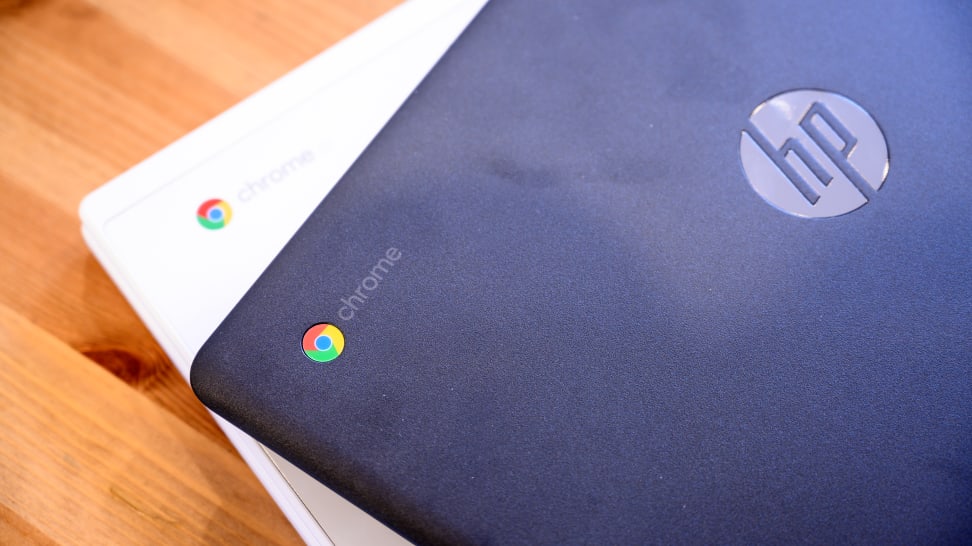 — Recommendations are independently chosen by Reviewed’s editors. Purchases you make through our links may earn us a commission.
— Recommendations are independently chosen by Reviewed’s editors. Purchases you make through our links may earn us a commission.We're currently testing new picks, so stay tuned!
Not everyone needs or can afford the latest, most powerful laptop out there. For simple tasks, such as running web-based apps such as Google docs, browsing the Internet, or sending an email, a low-powered, low-priced laptop fits the bill. That's where budget laptops come in.
Understand, you get what you pay for. Budget laptops often come with barebone specs: minimal drive space, memory, and slow processors. You won’t be able to use them to run the latest graphics-heavy computer games, but for giving your kids access to the web, sending a teen off to college with a computer for their studies or for you to stay up-to-date with Facebook, a budget laptop could be an ideal purchase.
Our top pick is the HP Envy x360 15z (available at HP), a 2-in-1 laptop with premium build quality and snappy performance that can be found for under $700 and competes with laptops that cost twice as much. Many of our picks are even more affordable, so there's sure to be a laptop for anybody.
While many of the budget laptops we tested weren’t very fast, most were more than capable of handling everyday tasks like web browsing and text editing with ease. We tested a mix of Windows laptops and Chromebooks to find the best laptops for every given price point.
These are the best budget laptops we tested, ranked in order:
- HP Envy x360 15z
- Lenovo Chromebook Flex 5
- HP Stream 14
- Acer Chromebook Spin 514
- Asus Zenbook 14
- Acer Aspire 5
- Google Pixelbook Go
- HP Chromebook x360
- Lenovo Ideapad 3
- Lenovo Chromebook Duet
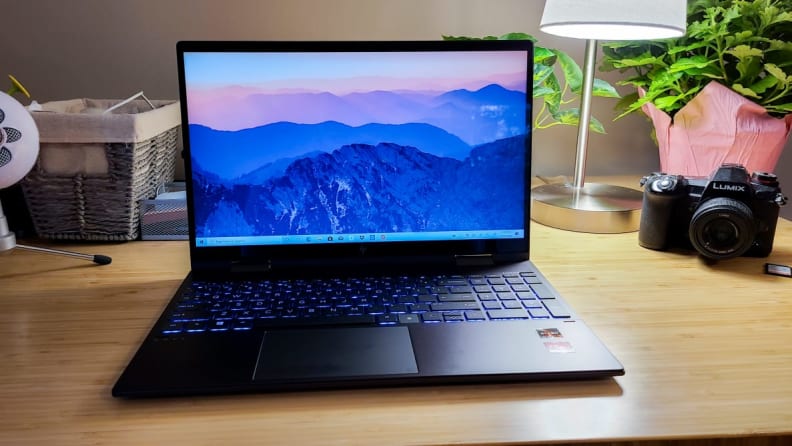

The HP Envy x360 15 gives you the most bang for your buck.
Fast, beautiful, and affordable, the 15-inch HP Envy x360 is a dream for those in need of a larger laptop that won't break the bank. Inside its beautiful body, the 15-inch Envy packs an AMD Ryzen 5 processor that trades blows with laptops twice its price—perfect for photo editing, light gaming, and even a bit of video editing.
The HP Envy’s 15-inch display is nothing short of glorious. It’s huge, it’s bright, it’s vibrant, and it’s touch-enabled. While the laptop is a little bulky for tablet use in 2-in-1 mode, it’s nice to have the ability to tent your laptop.
What's even more impressive is that it can hit all the marks while still delivering almost seven hours of battery life. While it doesn't outdo the MacBook Air, it's on par with other 15-inch laptops, like the HP Spectre 15 or the Dell XPS 15—despite its budget laptop status. It's undoubtedly one of the best 15-inch laptops in its price range, and we doubt we'll see a worthy contender for its crown anytime soon.
Pros
-
Excellent performance
-
A beautiful design
-
Sturdy 2-in-1 hinges
Cons
-
So-so battery life
-
Heavy


This 2-in-1 is an elegant Chromebook with a brilliant display and sleek aluminum body.
I never thought I could like a Chromebook as much as I like the Flex 5. It’s snappy, it feels luxurious, it looks classy, it has a nice screen, it’s affordable, and it has a flawless keyboard and trackpad. What doesn’t it have?
This is an excellent midrange Chromebook that succeeds as both a clamshell laptop and as a 2-in-1. It stands sturdy when I use it as a laptop, and the hinges snap nicely to make a seamless tablet configuration. If you want a machine for your everyday load, where you just want something that will be a pleasure to write, watch, read, and play on, the Flex 5 shines. It has a large, smooth trackpad with excellent tracking, a keyboard that I could easily type on for hours, and a touch screen that’s always sensitive to my fingertips.
I also had no problems with the screen, as it provided a picture that was great for YouTube and Netflix binging. It doesn’t have enough brightness to, say, read in a park on a sunny day, but it’s more than enough for use in a well-lit room. Because the Flex 5 runs ChromeOS, its 4GB of RAM and Intel Core i3 processor felt snappy no matter what I threw at it. However, while the Flex 5 outperformed quite a few higher-end processors in single-core benchmarks, it did not manage to match Intel’s Core i5 or AMD’s Ryzen 5 processors in multi-core benchmarks. That means it’s underpowered for the most intensive of tasks, such as video editing and 3D modeling, but it can handle lighter 3D games like Fortnite and bloated web browsers just fine.
If you want to take your Chromebook with you wherever you go, it will serve you for an afternoon or shorter plane ride, but you’ll want to have a USB-C charger on hand; in our tests, its battery lasted just 6 hours. This is by far this Chromebook’s biggest flaw, especially because Chromebooks are designed for exceptional battery life.
Despite its mediocre battery life, it’s still a great buy. Its construction feels solid and looks better than many other Chromebooks in this price range, and it packs enough power that I wouldn’t miss Windows and macOS. I’d absolutely recommend this to the average home user, especially with a budget of around $500 or less.
Pros
-
Premium build quality
-
Excellent display
-
Fast performance
Cons
-
Middling battery life
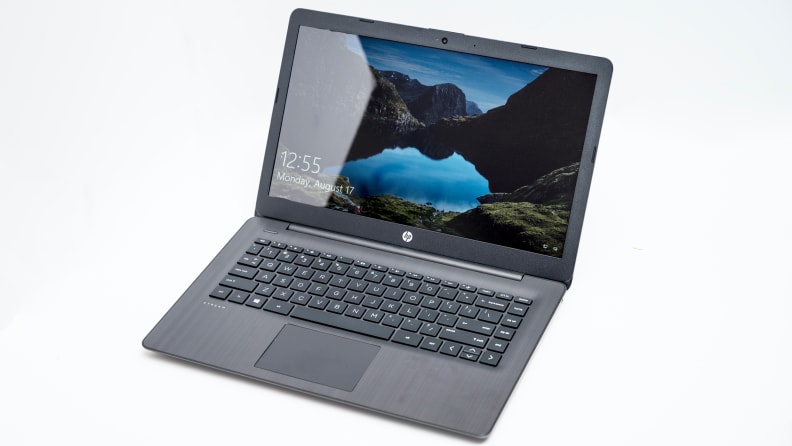
The HP Stream 14 is one of the cheapest, most readily available laptops running Windows 10.
If you’ve ever shopped for a laptop this cheap, you know the market is a bit of a minefield. We’ve been testing $200 and $300 laptops for years, and while it’s a challenge to find worthwhile machines, we’re always excited to share the gems we dig up.
The HP Stream 14 is barely over $200, and it won’t blow anyone away with its performance, but it works. Its 1366 x 768P display is washed out, but comfortable enough to read on and watch an occasional video. Similarly, the trackpad and keyboard will get you through any reports or emails you may need to type, but it may not be the best for your next big novel.
While our top laptops pack a punch with super-fast processors, the Stream 14 offers something closer to a gentle nudge with its performance. We run Cinebench to test most Windows 10 laptops, but the Stream only rendered about half the image after an hour of chugging (an entry-level, $400 Lenovo Ideapad 3 finished rendering the image in less than 15 minutes).
In real-world applications, even the most basic web pages took a couple of seconds to load, and anything beefier than a single Chrome tab was just a nightmare. The Stream 14’s measly 4GB of RAM and 32GB of storage mean that it can barely chug through the basic Windows processes, and adding anything else on top will notably reduce performance.
If you don’t need to buy a new laptop right now, I’d advise you to save a little more money and buy a more capable laptop. Even if you don’t mind the slow performance, the storage isn’t upgradeable and a 32GB drive will fill itself up with Windows patches alone. However, if you do need a new Windows laptop ASAP, this is one of the best laptops we’ve tested at this price range.
Pros
-
Good battery life
-
Passable keyboard
-
Looks decent
Cons
-
Extremely slow
-
Small storage drive
-
Runs bulky Windows 10
How We Tested Budget Laptops
The Testers
I'm Joanna Nelius, Senior Editor of Electronics at Reviewed. I've been reviewing gaming products and laptops for the last several years, having written for PC Gamer, Maximum PC, and Gizmodo in the past. In addition to gaming desktops and laptops, I also specialize in CPU and GPU reviews.
Hey there, I’m Adrien Ramirez, tech staff writer here at Reviewed. I’ve been working professionally with tech and PCs for six years, from game development to reviewing and everything in between. Before I came to Reviewed, I had worked with Lifewire and the MIT Game Lab. I’m passionate about all things tech, although I especially enjoy working with PCs. It takes a lot to make a great PC, and it takes a lot to know what a great PC looks like. It’s not just power—it’s build quality, touchpad sensitivity, keyboard ergonomics, display accuracy, aesthetics, and more. We all want our laptops and desktops to last as long as possible while giving us all the performance and comfort we asked for. When I’m not testing and evaluating laptops, I’m planning new keyboard and small form factor desktop builds.
The Tests
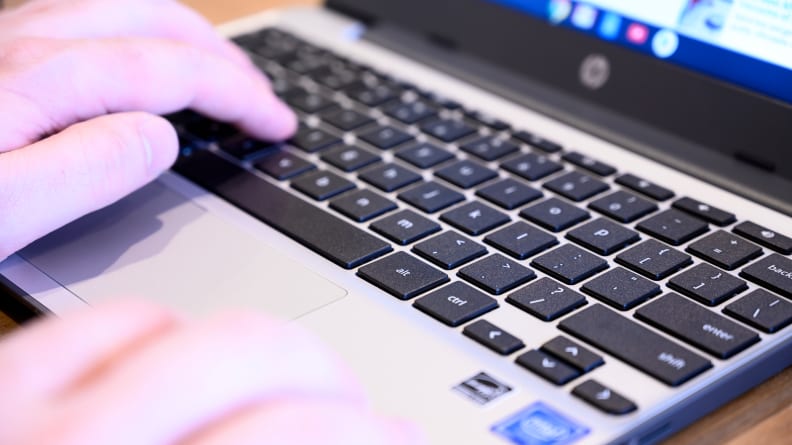
We use a standardized set of tests to assess each laptop we lay our hands on.
Our tests for these devices aren’t based purely on processing power. Instead, we look at the overall usability of the laptop, which also depends on the quality of the screen, the keyboard, what interfaces it offers, and many other factors. We test all of these factors and assign a score for each. Then, we rate the overall usability of the laptop as a combination of all of these factors by creating an overall weighted score.
First, we look at how well each laptop performs. Because the laptops in this guide are mostly designed for running web applications like Google Docs, we utilize the web-based benchmarks Basemark and Speedometer in the most popular web browser (Google Chrome). We also test with Geekbench 5 in order to compare its potential processing power across any app.
Most laptop displays do well in a dark room, but what about outdoors? Is a glossy screen better than a matte one? To figure out this information, we test the brightness on the display. We do this with a CS-200: it’s a handheld device that measures luminance and color accuracy. We measure the white levels and black levels at max brightness and then again at 50% brightness.
Next, we tested the battery life of each laptop to see how long you can use them for between charges. With their displays adjusted to a brightness of 200 nits, we set them to continuously cycle through popular websites, simulating the way you would use the laptop when idly browsing the web.
What You Should Know About Budget Laptops

A little bit of knowledge can help you make a better laptop buying decision.
When you purchase a cheap laptop, you’re investing in a series of compromises. They are equipped with low-end processors, memory, storage, displays, and keyboards: all in the name of providing consumers with the lowest-priced laptop possible. That’s not to say that these laptops are bad: Laptops that sell in the price range covered by this guide are still more than adequate for completing many tasks.
Their processors are fast enough to provide a smooth web browsing experience, allowing you to use many web apps and browser plugins, run uncomplicated software or play simple games. Using Google Docs or creating simple documents in Microsoft Word or Excel are reasonable tasks to ask of a sub-$500 laptop. Every one of the computers in this guide could handle writing essays for homework, researching schoolwork online, or making a presentation to show in class.
If you have a bit more space in your budget, many of the laptops we tested offer upgrade models that have faster processors and more drive space, which can make them more flexible for more demanding tasks. While you may not be able to run recently released major studio games on a budget laptop, you may be surprised to know how much more powerful these laptops have become in recent years. The Lenovo Ideapad 3, the second-cheapest Windows laptop on our roundup, can run Overwatch at about 35 FPS on medium settings.
Power
If you want to be able to play complex computer games or plan on using your computer to run power-hungry applications like Photoshop CC, we recommend spending more money on a laptop. You don’t need to own the best computer out there for these tasks (our best overall pick, the HP Envy x360, can handle it), but spending a little more on a midrange gaming laptop or ultrabook can land you a Windows 10 computer that you’ll be happy with for years to come.
Chromebooks versus Windows Laptops
As you compare Windows laptops to Chromebooks, you’ll notice that the budget laptops running ChromeOS are snappier than their Windows 10 counterparts, even though the Chromebooks tend to have lower-end processors or less RAM. This is because ChromeOS was built from a lightweight framework that takes a miniscule amount of processing power to run in comparison to Windows 10.
However, this does not mean that ChromeOS isn’t as capable as Windows 10. ChromeOS’s seamless integration with the Google cloud services allows it to take advantage of Google’s powerful suite of productivity tools and platforms, such as Docs, Sheets, YouTube, Stadia, and the Play Store. There is very little you can’t accomplish without a simple web browser these days, but if you feel somewhat limited by ChromeOS’s default settings, you can develop or install custom Unix programs by putting your Chromebook into Developer mode.
What Windows 10 offers over ChromeOS is compatibility with many legacy apps. You can download Microsoft Office on ChromeOS these days, but if you want to use something like Scrivener, you’d have to have Windows or macOS. Additionally, finding new Windows apps is easier, since you can download apps directly from developers’ websites instead of having to scrounge the Play Store in search of an app that meets Google’s criteria for approval.
Display Size
- 11-inch laptops: These tiny laptops are perfect for tossing in your bag and whipping out whenever. They’ve become less popular than they used to be, but they’re still a great choice for people who are constantly moving around.
- 13-inch laptops: These smaller laptops are also great for carrying around, and more than suitable for light work like writing papers and browsing the web. Their slightly larger size makes them easier to use for longer periods of time than 11-inch laptops.
- 15-inch laptops: Mid-sized laptops are a bit less portable, and won’t necessarily work in space-constrained spaces like airplane seats. But the larger display is useful for photo editing and watching videos.
- 17-inch laptops: This is very large, and only recommended if you are doing video editing or other intensive work that requires a lot of screen real estate—and you don’t mind lugging it around.
There can still be varying sizes within those categories—for example, the XPS 13’s smaller bezels make it much smaller than most 13-inch laptops—and sizes in between, like the 14-inch Lenovo Yoga C930. But in general, picking a size range you’re comfortable with can help narrow down the field.
Under the Hood
Finally, we need to discuss a computer’s base specifications: the hardware that determines how powerful your computer can be. For budget laptops, the most important hardware is the central processor (CPU), the working memory (RAM), and the storage drive.
The central processing unit is kind of like the brain of the computer. Nearly every operation the computer makes runs through the CPU. A good CPU excels at multitasking so that it can run several operations at once; this is why you’ll see CPU makers constantly trying to add more cores, or “brain parts” with each new model. Generally, more cores is better, but it’s also important to keep in mind that core speed will be more important if you’re not running anything super complex like a videogame.
At this price, you’ll usually see the CPU take charge of the graphics processing; many higher-end laptops and PCs have their own dedicated graphics processor (GPU) on top of the CPU’s integrated graphics processor. For browsing the web and using office software, lower-power mobile chips like Intel’s Pentium line or AMD’s A6 chips are adequately powerful, although you’ll get the snappiest performance out of entry-level mainline processors, like the Intel Core i3 and Core i5 chips or the AMD Ryzen 3 and Ryzen 5 chips.
If, on the other hand, you run more intense workloads—whether that means heavy photo and video editing or running the latest PC games—you’ll want something with a bit more “oomph.” The high-end Intel Core i7 and Core i9 chips and the AMD Ryzen 7 and Ryzen 9 chips will make those video encodes run noticeably faster, and a dedicated graphics card, like the Nvidia Geforce RTX 2060, will ensure your games run smooth as butter (instead of choppy like a bad flipbook). You may want to check out our guides for the best gaming laptops, best laptops under $1,000 or best laptops overall right now.
Meanwhile, the RAM is the information that the computer needs fast access to (your open web browser, the file you’re currently using, etc.). If the storage drive is your computer’s file cabinet, think of RAM as the files sprawled on your desk. 8GB is the sweet spot for RAM since this gives the computer enough space to breathe without adding needless costs. 4GB can work on ChromeOS laptops but expect to only run a couple of browser tabs at a time.
Finally, the storage drive contains all of your data—applications, documents, caches, the operating system, everything. While you want a lot of storage space, you also need to remember that a faster storage drive means a faster computer, and you can usually expand your storage space with micro SD cards and external storage drives. There are two main kinds of storage drives: hard disk drives (HDD) and solid-state drives (SSD). An SSD runs several times faster than an HDD, so it can make booting up programs much quicker and add to a laptop’s snappiness. They’ve gotten cheap enough that it’s more common to find an SSD than an HDD in laptops these days, but you may still find an HDD useful as secondary storage for files you don’t regularly access (old photos and videos, for instance). You’ll want at least 128GB of storage space on a Chromebook and 256GB of storage space on a Windows laptop for optimal performance.
Decoding the Naming Schemes
For CPU manufacturers, their naming scheme shows what kind of power is in the CPU. For Intel’s Core series, a Core i3 is the entry CPU, and a Core i9 is the flagship. In the sub-$500 market, it’s rare to see anything more powerful than an Intel Core i5. Their budget CPUs are called Celeron, and like with the Core CPUs, a higher number at the end means it’s newer or more powerful. We’re currently on the 10th generation of Intel CPUs, and the latest Celerons all start with 4000 (N4000, N4020, etc). Getting an older Core CPU (like an 8th gen Core i5) is usually fine for budget laptops, but you will notice worse performance from an older Celeron CPU.
AMD is much the same as Intel: a higher number in the name means a newer or more powerful CPU. AMD’s CPU lineups include the main Ryzen series and the budget A series. AMD processors are just as powerful as Intel processors. For AMD’s A-series, you may see A6, A8, and A10 processors. For AMD’s Ryzen series, you’ll likely see Ryzen 3, Ryzen 5, and occasionally Ryzen 7 processors in the sub-$500 range. A Ryzen 3 is about as powerful as an Intel Core i3.
Meanwhile, RAM is usually named by its data transfer rate. Most modern laptops have DDR4 SDRAM, which stands for “double data rate fourth-generation synchronous dynamic random-access memory.” Manufacturers are currently developing DDR5 SDRAM, and DDR3 is considered last-generation. Meanwhile, you’ll sometimes see RAM speed listed, as well. Most RAM has a speed of 2600 MHz to 4200 MHz or more. For most people, RAM speed doesn’t make a big difference, but if you need something to run blazing fast, you’ll want to consider RAM that’s 3600MHz or faster.
Other Budget Laptops We Tested

There are plenty of good reasons to pick up Acer’s Chromebook Spin 514, but the highlight of this machine is its processor. Like our top pick, the Lenovo ThinkPad C13 Yoga Chromebook, this is one of the few Chromebooks to come equipped with an AMD Ryzen 5 chip, which is far more powerful than the Athlon Gold and Silver processors Acer has used in some of its other Chromebook models.
While this Ryzen 5 chip does not have the same kind of power as those made for gaming laptops and productivity laptops, its speed puts many of the other processors you’ll find in Chromebooks to shame—even the Intel Core i3-10110U in the Samsung Galaxy Chromebook 2. Webpages and apps load faster, and if you have a good wireless internet connection, the Spin 514 is also a great cloud gaming machine.
The Spin 514 is sturdily built, too. The hinges are firm and hold the display in any position, whether that’s in laptop mode or tablet mode. The display is protected by Corning Gorilla Glass, which makes it more resistant to scratches and chips, and the chassis is made of reinforced metal. This makes it a great laptop for taking on the road, shoving into your bookbag, and even the occasional mishap.
Like the Samsung Galaxy Chromebook 2, the Acer Chromebook Spin 514 has some trouble recognizing trackpad gestures, mainly with scrolling through web pages. It takes a couple of tries swiping with two fingers for the trackpad to register what you’re trying to do. The keys also feel slightly soft, but there’s enough key travel to get a satisfying press. The keys are super quiet, too, so type away to your heart’s content—there’s no loud clack-clack-clack to distract anyone around you in a hushed library corner or study hall.
Aside from the minor trackpad issue, Acer’s Spin 514 has the right design and power for anyone who needs or wants a little bit extra out of a Chromebook.
Pros
-
Speedy performance
-
Sturdy build
Cons
-
Fussy trackpad
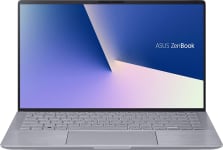
Compared to last generation’s Zenbook 13, the Zenbook 14 trades in an aluminum chassis and a gorgeous display for markedly better performance and battery life—all while maintaining the Zenbook line’s admirable portability. I’m a little disappointed to see the premium build quality go, but I would still say this is a good midrange buy with some of the best battery life and weight in its class.
While the chassis is not as glorious as I was expecting this generation, the silver plastic does a decent job of emulating the look of aluminum. The reason it’s such a sad swap is that this Zenbook has worse heat retention than the old one, and it is not as resistant to drops and dents. Even so, it is by no means a fragile butterfly.
Meanwhile, I have nothing but good things to say about its keyboard. It’s deeper and easier to type on, and it’s not as cramped as the Zenbook 13’s keyboard. The extra inch makes a difference. This model’s trackpad isn’t the glassy glider from, say, a Macbook, but it’s nonetheless comfortable to use thanks to its width and its excellent fingertip detection.
I was not impressed with the Zenbook 14’s screen. This matte 1080p panel's black level gets darker than last gen’s glossy screen, but it’s also 70 nits dimmer at max brightness. Its colors are also a bit more washed out than those of the Zenbook 13’s display.
One aspect where the Zenbook 14 far surpasses its predecessor is in performance, arguably the aspect that most affects your experience with a laptop. Its new Ryzen 5 4500U processor is blazing fast, crushing the old Intel Core i5-8500U in benchmarks, and its lower power consumption means the Zenbook 14 has a battery life of almost eight and a half hours.
Considering the Zenbook 14 is a solid, well-priced laptop that I do recommend, why have I spent so much time comparing it to the older Zenbook 13, you ask? Well, that’s because Amazon and other retailers are still selling the Zenbook 13 for slightly less than the Zenbook 14. I like both of these laptops a lot, so here’s my recommendation: if you want a faster laptop with a better keyboard, get the Zenbook 14; if you want a laptop that just refuses to break no matter how many commutes it takes, get the Zenbook 13. They’re both so light and long-lasting that you’d be happy with either of them as a traveling companion.
Pros
-
Fantastic battery life
-
Solid performance
-
Decent keyboard
Cons
-
Display is somewhat dull

The Acer Aspire 5 is a legend in the cheap laptop arena. For years, you could get an Acer Aspire and get an extremely fast laptop, with a ton of memory and storage, for around $550—with an upgraded model around $700. It was plastic, the screen was bad, and it was bulky (including a CD burner), but it was great for the price.
The updated Aspire 5 has an all-new design that sheds some of the thickness—and the CD burner, RIP—for a design that feels like a more conventional, affordable machine. It has chiclet-style keys, a mostly plastic body, and a raft of ports including a full-size HDMI, USB-C, three USB ports, and an honest-to-goodness Ethernet port. It also sports some updated design cues that lend it an air of class that the previous Aspire sorely lacked.
In our tests, the updated Aspire proved it’s still a great machine if you need a lot of power and ports on a budget. The machine was more than fast enough for basic tasks, though the battery lasted less than seven hours in our browsing test and the screen was fine, at best.
Unfortunately, the magic isn’t quite there. This is a great machine for the money, but there are a lot of laptops in this price range that are sleeker, faster, and offer better battery life. It’s good if you never, ever want to carry a dongle, but for everyone else, our top pick is a better, cheaper bet.
Pros
-
Great port selection
-
Elegant looks
Cons
-
Battery life could be better
If you want a Chromebook that feels like a MacBook, this is it. Google’s Pixelbook Go is a sleek sheet of matte black aluminum with a premium build quality. While you can get more powerful Chromebooks for the same exorbitant price, you’ll have a tougher time finding something that feels this durable.
There’s quite a bit to like about the user experience. The display is a gorgeous glossy touch screen that is incredibly bright, vivid, and full of contrast. Screens that look this good are rarely seen in this price range on ChromeOS or on Windows. Its large trackpad feels just as good, with a smooth glass finish and flawless gesture recognition.
I have mixed feelings about its ultra-quiet keyboard. It does manage to make virtually no noise, but it sacrifices feedback and subsequently makes it difficult for my fingertips to feel when the keys register.
With 8GB of RAM and an Intel Core M5-8500Y, the Pixelbook Go packs more power than most people would ever need of their Chromebooks. If you’re looking to play fast, intense games on it, then you’ll have no trouble running anything at high frame rates from the Google Play Store.
Where this Chromebook lags a bit behind its ChromeOS competitors is in its battery life. In our web-based battery test, the Pixelbook Go cycled through pages for 7 hours and 45 minutes before saying good night. Many cheaper Chromebooks could go for anywhere between eight and ten hours, but the Pixelbook Go falls right in line with midrange and premium Windows laptops.
We did, however, find better battery life in some Ryzen-based Windows laptops in the same price range (the Asus Zenbook 14 and the HP Envy x360 13t both made it past the 8-hour, 15 minutes mark). For $850, the Core M5 Pixelbook Go is a tough sell for anyone that isn’t looking for a top-line Chromebook and would settle for slightly worse build quality or a different OS for a fraction of the cost.
Pros
-
Solid aluminum body
-
Snappy performance
-
Gorgeous display
Cons
-
Battery life

It may not be mighty, but it sure is lovely. The HP Chromebook x360 is a 2-in-1 convertible Chromebook that feels sturdy and looks pretty in white. It comes with an optional stylus that really elevates the experience to something more organic, the pen gliding on the 4,096 levels of pressure like a pencil glides on photo paper.
This is a great tablet for students, as it allows them to take notes by writing them out or by typing them as they please. The Chromebook x360’s keyboard is surprisingly springy and stable for the price, and its touchpad is just as satisfactory. When you open your favorite video apps and sites, you’ll be treated to a bright, colorful display that looks much better than the price would suggest.
If you need a Chromebook that can handle a lot of tabs and programs simultaneously, this one may be a bit underpowered for you. However, if you’re looking for something a little more casual, maybe to check your email and read some ebooks, this little 2-in-1 has the perfect mix of features and functionality.
Pros
-
Snappy performance
-
Great battery life
Cons
-
Shallow keyboard
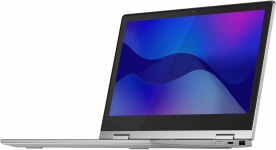
This humble Chromebook is just barely enough for the demands of modern life, but not for the demands of tomorrow. With a Celeron N4020 processor, the Flex 3 can juggle light web browsing and film watching. If you need something simple that just works, you won’t be disappointed—you just won’t be wowed, either.
While the 11-inch screen is only 1366 x 768 pixels, it gets pleasingly bright, is easy to read, and delivers flawless touch recognition. The Flex 3’s 10-hour battery life and fanless design make it a reasonably functional 2-in-1 for those that value price, silence, and portability.
While its build quality is indicative of its sub-$400 price tag, it’s by no means the worst in its class. The all-plastic silver chassis is rigid and sturdy, as are the hinges, the keyboard, and the trackpad. There’s nothing remarkable about the build, just as there’s nothing remarkable about its performance.
Pros
-
Good battery life
-
Lightweight
-
2-in-1 form factor
Cons
-
Slow performance
-
Mediocre audio

The Lenovo Chromebook Duet is the rare detachable Chromebook. Is it a Chromebook or is it an Android tablet? At just under $300, it’s priced like a Chromebook but, unfortunately, it runs like a slow, budget tablet.
Whether you’re streaming Netflix or writing an email, the Duet just constantly chugs along. Its MediaTek brain feels no pressure to outcompete other, more powerful Chromebooks (and tablets!) in the same price range. That said, when videos and ebooks finally load, the Duet treats you to a bright, vivid, 1920x1200p screen that’s crisper than what you get on most mid-range laptops.
You’ll also be hard-pressed to find a lighter Chromebook than this one-pound wonder. When you add the beautiful denim-ish keyboard case that’s included with the Duet, it still only weighs a little under 2 pounds, and this 10-inch detachable hits 10 hours of battery life on our browser-based test (one of the best scores we’ve seen for Chromebooks). It doesn’t get much more portable than this.
But, is the detachable form factor worth the portability? It depends on what you value. Because of limited onboard space, the Duet has a single USB-C port for both charging and accessories. Its cover, while elegant, is not all that practical, as its cardboard fold-back rear is prone to flopping over and causing repeated frustration when in “laptop” mode. When you manage to stabilize it, you will at least not be let down by its decent trackpad and keyboard.
I would skip this Chromebook for now, but I am excited to see what the next iteration of the Duet will look like. If it has more oomph and a sturdier case, it will make an awesome Chromebook and a worthy iPad rival.
Pros
-
Keyboard is detachable
-
Excellent battery life
-
Sharp screen
Cons
-
Very slow performance
-
Keyboard not very sturdy
